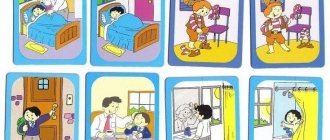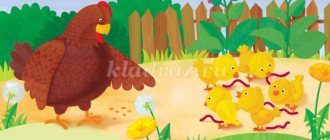Musical games for the younger group of kindergarten
Methodological development.
Musical games for younger preschoolers Author: Nadezhda Veniaminovna Zemlemerova, music director of MBDOU “Kindergarten No. 6 “Malachite” in the city of Cheboksary, Chuvash Republic.
This development will be useful for music directors and kindergarten teachers.
Can be used both in music classes and in leisure activities with younger preschoolers. Goal: Formation of motivation for musical activity; — development of musicality in children of primary preschool age. Objectives: - nurturing a child’s interest in the world of musical and non-musical sounds, elementary music-making;
- development in children of perception of musical and non-musical sounds; - enriching children's musical experience; — activation of children’s emotional reactions to music; — development of musical and game improvisations, performing skills and creative abilities in children. Junior group
“Guess the instrument” (A screen is installed, behind it there are musical instruments: bells, a drum, a rattle, a tambourine. The teacher reads a quatrain, calling the name of any child from the group, the Katya doll plays any musical instrument, the children guess
) The guys are playing, Let’s find out what it sounds like now, Play doll Katya!
Quickly, Olya, call me! “Quiet and loud palms” (Depending on the sound of the music, the children clap their hands either loudly or quietly)
We’ll play with palms, Loudly, loudly hit, One, two, three, don’t yawn, Loudly, hit loudly!
We'll play with our hands, Quietly, quietly, hit. One, two, three, don’t yawn, Quietly, hit quietly. “Rhythmic legs” (Children step to the rhythm of the music, now slowly, now quickly; at the same time, along with the steps, they knock with sticks)
We walk slowly, we raise our legs, we play with sticks, we hit each other.
We walk quickly, we raise our legs, we play with sticks. Let's hit together. “Children and the Bear” (Children walk around the entire hall, playing with rattles to cheerful music; when the bear appears, the music changes to marching music, the bear plays the drum; all the children hide from him and crouch)
The children went out for a walk to play with rattles, That’s how fun we are walking , We play rattles.
A bear came out with a drum, Boom-boom-boom, tram - there-there, All the guys hid, Here and there, here and there. “Musical mosaic” (Children are shown a picture with an image, a poem is told, the child chooses an instrument and portrays the one drawn in the picture.)
Here is a frog in the swamp, he lives very happily. Listen, guys, Kwa-kva-kva she sings!
The bear came out of the den, quickly run away, and when he began to roar, that’s how the little bear is! The rain is dripping on the roof, Knock-knock-knock, knock-knock-knock, Barely audible, barely audible, Knock-knock-knock, knock-knock-knock! The sparrows are cheerful, they start pecking at the grains, they don’t lag behind the others, they keep pecking, pecking, pecking. Here is a stream flowing, Apparently its path is far away, It is murmuring, splashing, trying to escape! “Funny balls” (To determine the contrast in music. For the first part of the music, the “balls” roll one after another or loosely, for the second part they bounce in place.) The
ball rolled, rolled along the path, We run like balls, These are the legs !
Suddenly our ball started jumping and jumping so merrily. We are like balls now. Let’s all jump together! “Little musicians” (Children play spoons for the first, fast part of the music, tambourines for the second, slow part). “Chickens and a fox” (The hens come out, peck the grains, clean the feathers. Then the fox runs out and catches the chickens: whoever it touches, he squats down)
Peck-peck-peck-peck, That’s how I peck the grains.
Peck-peck-peck-peck, That's how I peck grains. Yes, yes, yes, yes, I will clean the feathers. Yes, yes, yes, yes, I will clean the feathers. (fox runs out)
We recommend watching:
Water games for the second younger group. Card index Musical kaleidoscope in kindergarten. Scenario for children 4-5 years old An outdoor game with a tambourine for children 5-7 years old Musical educational games for kindergarten with presentation
Similar articles:
What are educational games for preschoolers
Games to develop attention for children 3-4 years old in kindergarten in a group
Didactic games in the younger group. Card index
Playing with sand in the younger group
Card index of musical and didactic games (according to the “Childhood” program) FIRST YOUNGER GROUP
Transcript
1 Card index of musical and didactic games (according to the “Childhood” program) FIRST YOUNGER GROUP “Fists and palms” Goal: development of a sense of ri M. E. Tilicheeva, words. Yu. Ostrovsky Source. Vetlugina N., Musical ABC book Purpose: Development of pitch hearing. Benefits. Doll “Sleep, dolls” Source. Vetlugina N., Musical ABC book Guess what I'm playing (1) Purpose: Development of timbre hearing Aids: Children's musical instruments: rattle, tambourine, bi-ba-bo dolls Parsley, bear, small screen “Petrushka and Bear” Russian folk melody Source . Vetlugina N., Dzerzhinskaya I., Komissarova L. First junior group Goal: Development of pitch hearing “Guess what I’m playing” Manuals. A pipe, a drum, a metallophone, a small screen “What I play on” by M. R. Rustamov, lyrics. Yu. Ostrovsky Source. Vetlugina N., Dzerzhinskaya I., Komissarova L. First junior group Purpose. Development of pitch hearing “Bird and chicks” Manuals. Picture with a picture of a tree and birds “Birds” by M. T. Lomova, “Bird and chicks” by M. E. Tilicheeva Source. Vetlugina N., Dzerzhinskaya I., Komissarova L. First junior group Goal: “Development of a sense of rhythm” Manuals. Doll “The doll walks and runs” “The doll walks and runs” p. Yu. Ostrovsky, m. E. Tilicheeva
2 Source. Vetlugina N., Dzerzhinskaya I., Komissarova L. First junior group “Cuckoo, Bunny, Bear” Purpose: Determining the nature of the music of the Manual. Cards with the image of a cuckoo, a hare, a bear “In the Forest” by M. E. Tilicheeva Source. Vetlugina N., Dzerzhinskaya I., Komissarova L. First junior group SECOND YOUNG GROUP “Fun and sad” Goal. Game to determine the nature of music. Two large cards with the image of a cheerful and sad gnome, sad-fun pictograms according to the number of children “Fun-sad” L Beethoven Source. O. P. Radynova “Music in kindergarten” part 1 Goal: Development of timbre hearing. Benefits. Trumpet, drum “Pipes and drum” “Trumpets and drum” p. Yu. Ostrovsky, M. E. Tilicheeva Source. Vetlugina N., Dzerzhinskaya I., Komissarova L. Second junior group Goal: Development of pitch hearing. Benefits. Chairs according to the number of children “Whose house?” “Whose house?” With. Yu. Ostrovsky, M. E. Tilicheeva Source. Vetlugina N., Dzerzhinskaya I., Komissarova L. Second junior group Purpose: Distinguishing the dynamics of music Manuals. Rattles according to the number of children “Quiet and loud bells” “Quiet and loud bells” p. Yu. Ostrovsky, m. R. Rustamova Source. Vetlugina N., Dzerzhinskaya I., Komissarova L. Second junior group Goal: Development of pitch hearing. “Guess” Benefits. Paired cards according to the number of children (cow-calf, goose-gosling, lamb, horse-foal)
3 Source. N. G. Kononova “Musical and didactic games for preschoolers” Purpose. Development of pitch hearing. “Where are my kids?” Benefits. Three large cards (duck, cat, chicken) and several small ones (ducklings, kittens, chickens) (according to the number of players) “Three sisters” Purpose: Determination of the character, dynamics, register, harmonization of music Benefits: Cards with the image of three girls (crying, angry, playing) D. Kabalevsky “Crybaby”, “Crybaby”, “Frolic” Source. O. P. Radynova “Musical development of children” Goal: Development of timbre hearing. “Guess what I’m playing on” Benefits. Musical instruments: rattle, spoons, tambourine, drum, screen, bi-ba-bo dolls: hare, cat, bear, hedgehog Any Russian folk melodies Purpose: Development of the sense of ri Benefits. Pictures “Hares are sleeping”, “Hares are dancing” Lullaby or dance music Source by N. G. Kononova “Musical and didactic games for preschoolers” Purpose: Game for the development of the sense of ri Manuals. Cards “Bears are sleeping”, “Bears are walking” Lullaby or dance music Source N. G. Kononova “Musical and didactic games for preschoolers” Purpose: Development of diatonic hearing MIDDLE GROUP “Find the puppy” Manuals. Puppy toy, 3 small barrels “Jump, Jump, Jump”
4 Goal Development of rhythmic memory, metrical sense Aids: Drum, bunny hat. Source: Internet. “Cat and Chickens” Purpose: Development of diatonic hearing. Benefits. Hats of cats, hens, chickens, kittens Musical material: Source: Internet “Guess what I’m playing on” Purpose: Development of timbre hearing Aids: Cards with the image of a triangle, tambourine, glockenspiel, pipe, drum Purpose: Development of modal sense “Clowns” Aids: Cards with the image of a cheerful and sad clown, pictograms. D. Kabalevsky “Clowns” Source by O. P. Radynov “Musical development of children” Purpose: “Development of pitch hearing” “Ladder” Aids: Cards with the image of a ladder with five steps. A girl walking up and down the path “Ladder” by E. Tilicheeva Source. N. Vetlugina “Musical primer” Purpose: Development of pitch hearing “Echo” Manuals. Cards with images of lost girls, metallophone “Echo” p. M. Dolinova, M. E. Tilicheeva Source. N. Vetlugin “Musical primer” “Think and guess” Goal: Development of pitch hearing and consolidation of program material Aids: Cards according to the number of players, which depict a bear, a bunny, a bird “Bunny” Russian folk melody, “Bear” by V. Rebikov, “Sparrow” M. Krasev Goal: Development of a sense of ri Manuals. Cards with the image of a bear, fox, wolf Musical material: “Who walks as they go” p. V. Stepanova, M. G. Levkodimova
5 Source. L. N. Komissarova, E. P. Kostina “Visual aids in the musical education of preschool children. A manual for educators and musicians. heads of kindergartens “Birthday” Purpose: Determination of the nature of music Benefits. Soft toy hare, small gifts, pictures with images of “guests” “Hedgehog” by D. Kabalevsky, “Royal March of the Lion” by C. Saint-Saens, “Elephant” by C. Saint-Saens Source. Z. Ya. Root “Musical and didactic games” “Bird and chicks” Purpose. A game to consolidate knowledge about pitch and develop children's creativity. A picture depicting a tree whose branches are arranged in the form of a staff, large and small birds “Musical chicks” Z. Root Source. Z. Ya. Root “Musical and didactic games” Purpose: Development of a sense of ri Manuals. Flat cardboard figures, painted in the Russian style of Mikhail Potapych, Nastasya Petrovna, Mishutka. Cards for children with the image of three bears and circles, metallophone Source Z. Ya. Root “Musical and didactic games” Purpose. Game for developing memory and hearing “How many birds are singing” Benefits. Cards with pictures of birds, a picture of a gnome Musical material: Source. N. Vetlugin “Musical primer” “Do you know the music of P. I. Tchaikovsky” Purpose: Development of musical memory Manuals. Pictures depicting the heroes of the sounding works of P. I. Tchaikovsky “Baba Yaga”, “New Doll”, “Kamarinskaya”, “Waltz” Source by L. N. Komissarova, E. P. Kostina “Visual aids in the musical education of preschool children. A manual for educators and musicians. heads of kindergartens. “Fun Train” Objectives: Strengthening the ability to distinguish changes in the tempo of music. Benefits: Small toy steam locomotive by E. Tilicheev “Wheels of a Steam Locomotive”
6 Source L. N. Komissarova, E. P. Kostina “Visual aids in the musical education of preschool children. A manual for educators and musicians. heads of kindergartens. Target. Game for developing a sense of rhythm. Benefits. Rattles “The Month of May” Nursery rhyme Source. N. Vetlugina “Musical ABC book” Senior group “Swing” Goal. Game for the development of pitch hearing. Benefits. Picture “Swing” by M. E. Tilicheeva, p. L. Smoke" Source. N. Vetlugina “Musical ABC book” Purpose. Timbre recognition game Manuals. Metallophone “Guess who’s singing” “Who’s singing” p. A. Gangova, M. E. Tilicheeva Source. Vetlugina N., Dzerzhinskaya I., Komissarova L. Senior group “Whom the bun met” Goal. Game for the development of musical memory and hearing. Benefits. Pictures of a bun, a fox, a hare, a bear, a wolf “Whom the bun met” by M. Levkodimova Source by L. N. Komissarova, E. P. Kostina “Visual aids in the musical education of preschool children. A manual for educators and musicians. heads of kindergartens. "Two Reels" Goal. Game for the development of pitch hearing. Benefits. Big and small drums “Two drums” p. Yu. Ostrovsky, M. E. Tilicheeva Source Vetlugina N., Dzerzhinskaya I., Komissarova L. Senior group Purpose. Game for mastering the character of music “Amazing Traffic Light”
7 Benefits. A flannelgraph, a large traffic light, cards for each child with a picture of a traffic light and three chips. Inside the lantern circles at traffic lights, children perform three actions: sleep, march, dance. At the choice of the music director Source. Z. Ya. Root “Musical and didactic games for preschool children” Purpose. Discrimination game “Fists and palms” p. Yu. Ostrovsky, M. E. Tilicheeva Source. Vetlugina N., Dzerzhinskaya I., Komissarova L. Senior group Goal. Game for the development of ri Benefits. Pictures of rooster, hen and chicks. Target. Game to distinguish the nature of music. Benefits. — “We are military” by L. Sidelnikov “Trumpeter”, “Infantrymen”, “Cavalrymen” Source. Vetlugina N., Dzerzhinskaya I., Komissarova L. Senior group Goal. Game to develop the sense of ri Benefits. Flat figures of nesting dolls, metallophone, wooden spoons Russian folk melody “The month is shining” Source. Z. Root “Musical and didactic games for preschool children “Find out what instrument sounds” Goal. Introduce children to stringed, percussion, noise instruments, teach them to classify them, grouping them based on common characteristics; develop logical and imaginative thinking, attention, speech Benefits. Cards with images of musical instruments Source. "Merry Tones"
8 Purpose. Game for developing a sense of rhythm. Benefits. Drawings of a steam locomotive and steamship, cards (30*9 cm) and three strips of cardboard: wide (3*6 cm) long sound, narrow (1.5*6 cm) short. Source. Z. Ya. Root “Musical and didactic games” “Bird and chicks” Purpose. Game for the development of pitch hearing. Benefits. A card with a picture of a tree, the branches of which are arranged in the form of a staff, large and small birds. Source. Z. Ya. Root “Musical and didactic games” “Learn a fairy tale” Goal. Distinguish the contrasting nature of parts in music in connection with its content and the development of the musical image. Benefits. Cards with the image of a wolf and Little Red Riding Hood, a set of colored stripes in two different colors. “Little Red Riding Hood and the Gray Wolf” G. Levkodimov Source: L. N. Komissarova, E. P. Kostina “Visual aids in the musical education of preschool children” “Loudly and quietly binge drinking” Purpose. Game for the development of diatonic hearing Benefits. Any toy “Sound out natural phenomena” Purpose. A game for the development of associative thinking. Benefits. Cards for each child, pictures of instruments At the choice of the music director. Kolobok Goal. Game for the development of diatonic hearing Benefits. A hammer, a bun and several different small objects PREPARATORY GROUP “Sun and Cloud” Goal. To develop in children an idea of the different nature of music: cheerful, cheerful music; calm, sad'. Benefits. Cardboard cards with the image of the sun, with a cloud, the sun behind the cloud
9 Musical material: D. Kabalevsky “Rondo March”, S. Prokofiev “A Moon Walks Over the Meadows”, M. Krutitsky “Winter” Source: L. N. Komissarova. E. P. Kostina “Visual aids in the musical education of preschool children” “Jingle bells” Purpose. Game for the development of pitch hearing. Benefits. Cards according to the number of players, on each are drawn three rulers, colored circles, three musical bells, a metallophone “Jingle Bells” p. M. Dolinova, M. E. Tilicheeva Source by L. N. Komissarov. E. P. Kostina “Visual aids in the musical education of preschool children” “The Three Little Pigs” Purpose. Game for the development of pitch hearing. Benefits. Cards with the image of the three little pigs Goal. Game for developing a sense of ri Benefits. Cards depicting short and long sounds Purpose. Game for developing a sense of ri Benefits. Cards, on one half of which a rhythmic pattern of a song familiar to children is depicted, the other half is empty, pictures illustrating the content of the song, children's musical instruments “Guess what I'm playing” Purpose. Introduce strings, percussion, noise instruments, learn to classify them, grouping them based on common characteristics, develop logical and figurative thinking, attention to speech. Benefits. Cards with images of musical instruments. Source. Internet
10 “Musical conversation” Purpose. Development of children's singing creative abilities. Benefits. Picture At the choice of the music director Source. Internet Goal. Development of pitch hearing “Scientific grasshopper” Manuals. Picture with flowers and a learned grasshopper, metallophone Source. L. N. Komissarova, E. P. Kostina “Visual aids in the musical education of preschool children” “Choose a picture” Goal. To develop in children the ability to distinguish the figurative nature of music, to correlate an artistic musical image with images and phenomena of reality. Benefits. Two winter landscapes with different moods. V. Agafonnikov “Sleigh with bells.” Source: L. N. Komissarova, E. P. Kostina “Visual aids in the musical education of preschool children” “Bouquets” Purpose. Game for developing a sense of rhythm. Benefits. Small-sized flowers, daisies and cornflowers, two for each child, tambourine Source: L. N. Komissarova, E. P. Kostina “Visual aids in the musical education of preschoolers” “Determine the form of a piece of music” Goal: To develop in children the ability to distinguish contrasting parts in music, introduction and conclusion. Benefits: Squares, triangles, circles of different colors. Musical material: G. Levkodimov “A Little Piece”. Source: L. N. Komissarova, E. P. Kostina “Visual aids in the musical education of preschool children: A manual for educators and musicians. heads of kindergartens." “What a musical instrument will tell about itself” Goal: To develop timbre hearing. Benefits: Two identical sets of musical instruments, box. Source: M. A. Mikhailova “Development of children’s musical abilities. A popular guide for parents and teachers “Listen, Hear, Discriminate”
11 Goal: To develop the perception of music, musical taste. Musical material: P. I. Tchaikovsky “Polka”, D. B. Kabalevsky “Clowns”, S. S. Prokofiev “Fairy Tale”. Source: M. A. Mikhailova “Development of children’s musical abilities. A popular guide for parents and teachers." “Let's touch the music” Goal. A game for developing creative imagination. Benefits. Plates that feel different to the touch Source. M. A. Mikhailova “Development of children’s musical abilities. A popular guide for parents and teachers." “Wonderful little ladder” Purpose: To develop in children the ability to correlate sounds in height, to distinguish the direction of movement of a melody. Benefits: A card made of thick cardboard with an image of a ladder, the steps of which are painted in different colors; five round chips corresponding to the color of the stairs. Source: L. N. Komissarova, E. P. Kostina “Visual aids in the musical education of preschool children. A manual for educators and musicians. heads of kindergartens."
“Interactive musical and didactic games for young children”
Interactive musical and didactic games
for young children.
MBDOU "Kindergarten No. 16"
Teacher of the first qualification
categories Belova E. N.
The use of information and communication technologies in the teaching and educational process in a preschool educational institution is one of the newest and most pressing problems in domestic preschool pedagogy. The specificity of introducing a personal computer into the process of educating preschoolers in our country is that computers are first used in the family, then in kindergarten - in conditions of collective education. Using a computer as a means of educating and developing a child’s creative abilities, shaping his personality, and enriching the intellectual sphere of a preschooler allows him to expand the teacher’s capabilities and creates the basis for introducing children to computer educational programs.
Interactive musical and didactic games are one of the means of developing a child’s musical culture. They contribute to the development of children's ear for music, sense of rhythm, and creative abilities.
Interactive musical-didactic games are a gaming method of teaching aimed at mastering, consolidating and systematizing knowledge about music, as well as a gaming form of learning and independent gaming activity, a means of musical communication and child development.
The significance of the development of rhythmic hearing in the musical education of a child is that it:
-helps develop musical abilities and enriches the emotional world of children;
-develops cognitive abilities;
- fosters activity, discipline, and a sense of teamwork;
In music classes and in free time from educational activities, you can use computer educational and educational games aimed at preschoolers, thereby arousing interest in this educational area and developing the creative and intellectual abilities of children.
Interactive musical and didactic games are of particular importance in the development of musical and rhythmic hearing. Games should be simple and accessible, interesting and attractive. Only in this case do they become a kind of stimulant of children’s desire to sing, listen, play, and dance. In the process of playing, children not only acquire special musical knowledge and abilities, but they also develop the necessary personality traits, primarily a sense of camaraderie and responsibility. All interactive didactic games contribute to the formation of mental qualities in children: attention, memory, intelligence; are taught to act quickly, to be restrained, and to evaluate one’s own capabilities; activate various mental processes, contribute to the process of learning and education; enrichment of vocabulary.
Progress of the game:
An adult begins a fairy tale:
“There is a little mansion in the field,
He is not short, not high, not tall.
Is there someone running across the field towards the house?
Here across the field, is someone in a hurry to the house?”
Children listen to music and determine which fairy tale character by the sound.
she comes up. A child who correctly guessed whose music is playing ,
goes out to the playing field and inserts the corresponding figure of the fairy tale hero into the slot in front of the house.
2. Development of dynamic hearing
2.1. "Silent and loud bells"
Goal: to develop dynamic hearing.
Game material: rattles or noise toys according to the number of children.
Progress of the game:
The teacher invites the children to go for a walk in the clearing drawn in the picture : “Little bunnies live here, and you will find out what they do when you listen to the music . The melody of a lullaby or dance music , the children identify it and insert it
4. Games for genre identification and memory development
4.1. The song came to visit
Goal: Develop musical memory .
Game material: Magic bag and toys, characters from children's songs.
Progress of the game: The teacher brings a magic bag to the group, examines it, and makes assumptions about what it could be.
Educator: The song came to visit
And she brought a gift.
Come on, Tanya, come over,
What's in the bag, look!
The child takes a toy out of the bag. The teacher offers to remember the song in which this character appears: cat, mouse, horse, bunny, car, bird, etc. The teacher invites the children to sing the song individually, in choir or ensemble.
Note: The song is not necessarily about a toy. The hero may simply be mentioned in a song.
4.2. "Wonderful bag"
Game material. A small bag, beautifully decorated with applique. It contains toys: a bear, a hare, a bird, a cat, a cockerel. You can use characters from the puppet theater (Fig. 6)
.
Progress of the game. The whole group participates. “Children,” says the teacher, “guests came to our lesson. But where did they hide? Maybe here? (Shows the bag.)
Now we’ll listen to
the music and find out who’s there.” The music director plays melodies of works familiar to the children: “Cockerel”
- a Russian folk melody,
“Grey Cat”
by V. Vitlin,
“Sparrows”
by M. Krasev,
“Bear”
by V. Rebikov, etc. Children recognize
the music , one of them gets from the bag the corresponding toy and shows it to everyone.
4.3. "Find a toy"
Game material. Toys corresponding to the content of the songs: bunny, bear, cat, cockerel, etc.; laptop with recordings of program works.
Progress of the game. The toys are on the table. Children sit in a semicircle. The teacher offers to listen to the melody and choose (says the child’s name)
appropriate toy.
The game ends when there are no toys left on the table. The game can be played in class to reinforce familiar works and in free time from classes (preferably in the afternoon)
.
5. Emotional perception of music .
5.1. "Walk"
Equipment: flannelgraph and cards depicting short and long sounds.
How to play: Wide cards correspond to long sounds, narrow cards to short ones.
Example: Tanya took the ball and began to slowly hit the ground.
“It began to rain frequently and heavily”
children quickly clap their hands and lay out narrow
,
etc. d. 5.2. “Who went out for a walk?”
Goal: To present an appropriate image to the music and convey it in motion.
Game "Silence and Noise"
You can play both in kindergarten and at home. The lesson is designed to correct behavior. It helps to make the child organized, disciplined, and also develops auditory perception and concentration.
When the parent speaks quietly, the baby should tiptoe without making noise. And when it’s loud, you can make noise, rush around, shout. It is important to explain that you need to focus your actions not on words, but on the power of your voice. If the parent orders to make noise, but speaks quietly, then the baby should behave calmly.
Increase the difficulty gradually. Give volume-appropriate instructions first. For example: “Walk on tiptoe” in a quiet voice or “Jump” in a loud voice. Next, complicate the lesson, give tasks that do not match the volume. For example: “Clap your hands” quietly or “Walk on tiptoe” loudly. To make the game even more challenging, start changing tasks and volume suddenly.
Features of children's development
Play in kindergarten is the main type of activity that can effectively influence the quality of education of preschool children, especially for students in the younger group. Based on this, the teacher can use musical and didactic techniques that help develop the child’s creative abilities, including hearing, memory, concentration and many other most useful skills.
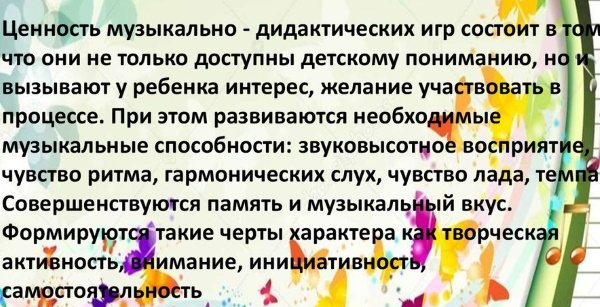
There are numerous studies that indicate that music has a particularly positive effect on the development and improvement of a child’s skills. Those children who are exposed to musical beauty and aesthetics from an early age are much more able to master the school curriculum in the future.
A child whose development includes musical practice has higher intellectual and creative abilities than those who did not use musical and didactic material.
Musical and didactic games for the younger group have the following tasks and goals that set them apart from other pedagogical methods:
- improving the child’s creative skills;
- formation and development of musical taste and hearing;
- introducing a child to the art of music;
- improvement of sensory abilities;
- motivation for independent activity in various fields.
Didactic games can be used in different classes. Thus, with the help of simple musical instruments and accompanying pictures, a child can be taught to count or develop the speech apparatus more effectively.
In addition, the introduction of musical and didactic practice better acquaints the preschooler with folk art, and also introduces him to the importance of visual perception of the world around him. Thus, the child perceives incoming information more effectively, learns to draw conclusions and analyzes.
Game "Bells"
Kindergarteners of the middle group are playing. For the lesson you need to prepare a box with rattles.
The purpose of the musical-didactic game “Quiet and Loud Bells” is to develop musical hearing and perception of sounds of different heights.
Tasks:
- learning the ability to distinguish between soft and loud sounding music;
- learning the skill of playing musical instruments quietly and loudly;
- development of concentration;
- nurturing interest in music and musical instruments;
- training in teamwork skills.
Pupils examine rattles. The rule of the musical-didactic game “Loud-quiet”: when the teacher plays music quietly, the children should play the same way. When the teacher starts playing loudly, then the children should rattle the rattles louder.
The teacher begins to play music, the students rattle their toys to the beat in accordance with the strength of the sound. Then the teacher complicates the task: he begins to sing, and the participants, based on the strength of his voice, must determine how to shake the rattles.
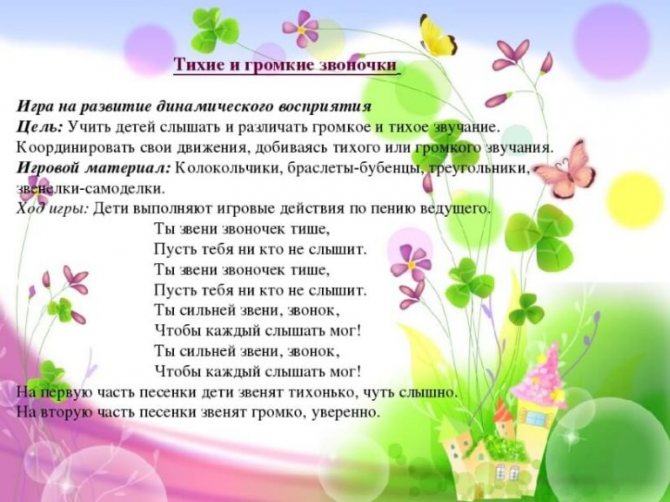
Didactic game "Quiet-loud"
The purpose of the lesson is to teach the ability to change the volume of the voice, to reinforce the correct pronunciation of sounds.
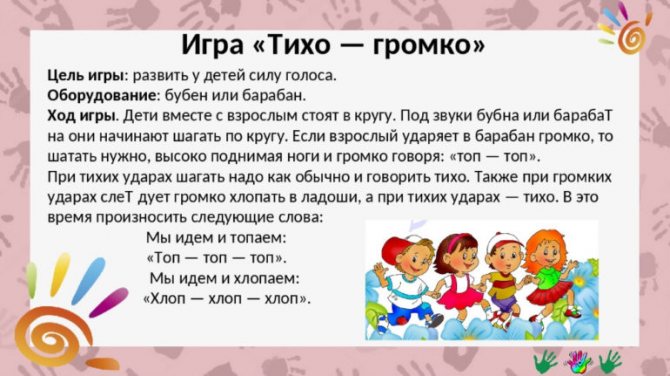
Children of the younger group of kindergarten are playing. The teacher needs to prepare different-sized pairs of toys: large and small - drums, rattles, cars, bells.
The teacher takes a couple of objects and explains to the students: “The big car beeps loudly, “Beep-Beep,” and the small one, quietly, “Beep-Beep.” Participants repeat the sounds of cars after the teacher. Next, the teacher, having hidden the cars, gives the task: “When you see a big car, beep loudly, when you see a small car, beep loudly.”
When children see the toy and begin to make a sound, make sure that their voice does not turn into a whisper.
Classes with other toys are carried out in a similar way.


